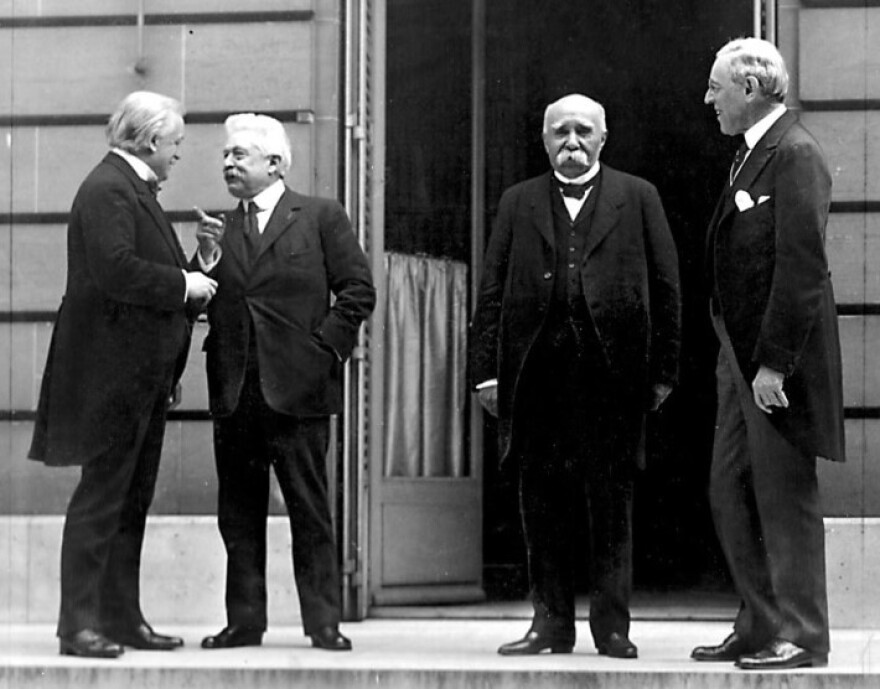In April 1919, President Woodrow Wilson was in Paris negotiating the future of Europe following World War I when something went wrong, according to John M. Barry, author of The Great Influenza: The Story of the Deadliest Plague in History.
“Wilson got very sick,” Barry said. “His doctor was with him, the White House physician Cary Grayson, and Grayson himself said it was one of the worst nights of his life, trying to see Wilson through the night.”
Barry said the president got so sick, so suddenly, that Grayson thought he might have been poisoned. But it became clear fairly quickly that Wilson had become one of the planet’s 500 million people infected with the H1N1 flu virus, which ultimately killed an estimated 50 million people worldwide.
“Wilson was in bed for about five days,” Barry said. “This was in the middle of the Paris Peace Conference. He was still too sick to go to the conference, but both the British and French prime ministers came to his room and negotiated.”
The president suffered from extreme fatigue, high fever, disabling coughing fits and shortness of breath, according to Barry.
But it was the changes in his thinking and behavior -- including disorientation and delusions -- that posed a greater hindrance to the negotiations, which would eventually result in the Treaty of Versailles.
Barry said the White House physician worked hard to keep the seriousness of the president’s condition a secret. When his illness leaked, Barry said, Grayson claimed the president simply had a cold.
A century later, another president was infected with another virus during a pandemic. This time the world was well aware of it.
The world also knows much more about COVID-19 than it did about the novel H1N1 strain of the influenza virus that sickened much of the world in 1918 and 1919.

Dr. Jason Bowling, an expert in infectious diseases at UT Health San Antonio, explained that today's scientists know most people who are infected with the COVID virus -- including those in their seventies like the president, who is 74 -- will survive.
“Particularly now we've had advances of what care we can give people compared to the beginning of the pandemic, when we had less treatments, and we didn't fully understand what we could use,” Bowling said.
However, according to the Centers for Disease Control and Prevention, for people older than 65, their risk of severe COVID-19 increases dramatically. CDC said people between the ages of 65 and 74 face a five times greater risk of hospitalization and a 90 times greater risk of dying from COVID compared to those between the ages of 18 and 29.
President Trump has a couple of other known risk factors, Bowling said.
First, he is overweight. CDC said people who were obese were three times more likely to end up in the hospital with COVID-19, and those with a Body Mass Index over 40 were more likely to need a ventilator.
Second, he is a man. “In some studies, there's data that suggests that being male, for reasons that aren't fully understood, can put you at higher risk as well,” Bowling said.
Even more concerning, Bowling said, was that added risk factors may exponentially add risk.
“There's some data that shows the more risk factors you have, the higher your risk for having more severe illness definitely occurs,” Bowling said. “It's not clear if they're additive, or to what degree, but definitely having more risk factors puts you at higher risk of more severe illness, the need for hospitalization, ventilation ... those kinds of things.”
Knowing all of that, and with the understanding that symptoms of this disease can escalate quickly, Bowling said the hospital was probably the best place for the president, instead of treating him at the White House.
The medical setting would allow for constant, intensive monitoring. It would also enable doctors to administer experimental treatments that are currently only administered in the hospital, like Remdesivir. The president was reportedly on a five day regimen of the antiviral medication, which is administered intravenously, once a day.
— Donald J. Trump (@realDonaldTrump) October 3, 2020
The White House physician has also reported that President Trump received an experimental antibody treatment that is currently only available to those enrolled in research trials. Trump was granted a Food and Drug Administration “compassionate use” exception before being treated with a monoclonal antibody cocktail from pharmaceutical company Regeneron.
“Basically, what you're doing with that is you're trying to use antibodies early on, to prevent the virus from being able to increase in numbers and cause more severe illness,” Bowling explained.
“The idea is that if you haven't experienced that infection before and haven't had a vaccine, you won't have antibodies," he explained. "But if you can use monoclonal antibodies, that'll help drive the virus down before it's allowed to increase the number and cause more severe sickness.”
Doctors remained optimistic on Saturday that Trump would recover fully.
But history has recorded that Wilson wasn’t so lucky. His peace talks went poorly. He came away from negotiations with almost none of what he had said was important to him as he led the U.S. into one of the greatest wars human civilization had ever experienced. Some members of Wilson’s inner circle reported the president never really recovered, according to Barry.
“After his illness, he just couldn't process information. He couldn't make a decision,” Barry said. “He could be pushed around.”
Barry also thought it was reasonable to link Wilson’s experience with H1N1 to a serious stroke he suffered later in the year that left him paralyzed.
The full impact of that stroke on the president’s ability to run the country was also obscured from everyone outside of Wilson’s immediate circle. Many historians agree that for the rest of Wilson's presidency, which ended in 1921, First Lady Edith Bolling Galt Wilson secretly ran the country for her husband.


